Nissan Silvia
The Nissan Silvia (Japanese: 日産・シルビア, Nissan Shirubia) is the name given to the company's long-running line of sport coupes based on the Nissan S platform. Although recent models have shared this chassis with other vehicles produced by Nissan (most notably the European 200SX and North American 240SX in the S13 and S14 generations, and 180SX in the Japanese market), the name Silvia is interchangeable with the chassis codes. The Nissan Silvia's main competitors worldwide were the Honda Prelude, Mazda MX-6, Toyota Celica, Mitsubishi Eclipse, Isuzu Impulse, Subaru Impreza and Honda Integra.
| Nissan Silvia | |
|---|---|
Nissan Silvia (S15) | |
| Overview | |
| Manufacturer | Nissan |
| Production |
|
| Body and chassis | |
| Class | Sports car |
| Layout | Front-engine, rear-wheel-drive |
The "Silvia" name is a variation of the word "sylvia", which is a scientific genus term assigned to a class of birds, possibly a reference to the Bluebird which was in production at the time the Silvia was introduced.
CSP311
| Nissan Silvia (CSP311) | |
|---|---|
 Nissan Silvia (CSP311) | |
| Overview | |
| Also called | Datsun 1600 Coupe[1] |
| Production |
|
| Assembly | Hiratsuka, Kanagawa (Nissan Shatai Plant) |
| Body and chassis | |
| Body style | 2-door coupe |
| Platform | Datsun CSP311 platform |
| Related | Datsun Fairlady SP311 |
| Powertrain | |
| Engine | 1.6 L R I4 |
| Transmission | 4-speed manual |
| Dimensions | |
| Wheelbase | 2,280 mm (89.8 in) |
| Length | 3,985 mm (156.9 in) |
| Width | 1,508 mm (59.4 in) |
| Height | 1,275 mm (50.2 in) |
| Curb weight | 977 kg (2,154 lb) |
The Nissan Silvia CSP311 made its public debut at the Tokyo Motor Show in September 1964 as the "Datsun Coupe 1500". The introductory model was a hand-built coupe based on the Fairlady convertible, styled with input from Count Albrecht Goertz. Its appearance is similar to the Lancia Fulvia coupe. The CSP311 was powered by the 96 hp 1.6 L Nissan R series engine. The engine was equipped with twin SU carburetors. Production ceased in 1968 after a mere 554 were made (mainly in 1965), each one of them unique with body panels crafted by hand. Most of the vehicles remained in Japan; however, 49 examples were exported to Australia and another 10 went to other countries.
The low production numbers and tedious method of construction assured that each car was unique and valuable; this is reflected by the car's purchase price of almost twice as much as the next model in the manufacturer's lineup at the time. After production ceased in 1968, the Silvia nameplate would not grace another Nissan vehicle until 1974. Its marketing approach was similar to the Isuzu 117 Coupé. In Japan, it was sold at Nissan Bluebird Store locations, and was marketed with the "Nissan" name instead of the more widely used "Datsun" brand name.
S10
| Nissan Silvia (S10) | |
|---|---|
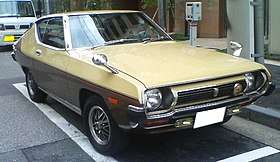 | |
| Overview | |
| Also called |
|
| Production | 1975–1979 |
| Assembly | Zama Plant, Zama, Kanagawa, Japan |
| Body and chassis | |
| Body style | 2-door fastback |
| Platform | Nissan S platform |
| Related | Nissan Sunny |
| Powertrain | |
| Engine | |
| Transmission | |
| Dimensions | |
| Wheelbase | 2,340 mm (92.1 in) |
| Length | 4,135 mm (162.8 in) |
| Width | 1,600 mm (63.0 in) |
| Height | 1,300 mm (51.2 in) |
| Curb weight | 990 kg (2,180 lb) |
The S10 was the first mass-produced Silvia built on the all-new S platform, intended as Nissan's compact, rear-wheel-drive, sporty car platform.[3] Japanese versions were exclusive to Nissan Japanese dealerships called Nissan Prince Store along with the larger C110 Skyline.
The S10 featured less "traditional" lines than similar offerings from rivals Toyota and Mazda sharing a common appearance with the larger Skyline. In Japan it was fitted with a 1.8 L L18 inline-4 engine, which it shared with the Datsun 610/Bluebird 180B. The Japanese version featured Nissan NAPS emission control technology at its introduction. In the North American market a version incorporating the larger-displacement 2.0 L L20B was offered as the 200B of the same series Bluebird and Skyline. This model in North America was affixed with the mandated 5 mph (8.0 km/h) bumpers and badged as the Datsun 200SX. The S10 Silvia and Datsun 200SX were based on the Datsun Sunny Coupe. Its success in both markets was limited, most buyers opting for the Celica over what was considered the more mundane S-Chassis. The car had the same drivetrain as the popular 510, but with leaf springs fitted at the rear, rather than the 510's independent suspension.
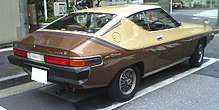
S110
| Nissan Silvia (S110) | |
|---|---|
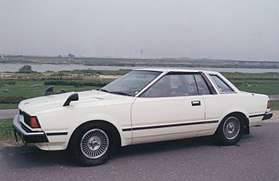 Nissan Silvia 2000 ZSE-X Coupé (Japan) | |
| Overview | |
| Also called |
|
| Production | 1979–1983 |
| Assembly | Kanda, Fukuoka (Nissan Shatai Plant) |
| Body and chassis | |
| Body style | |
| Platform | Nissan S platform |
| Related | Nissan Stanza |
| Powertrain | |
| Engine | |
| Transmission |
|
| Dimensions | |
| Wheelbase | 2,400 mm (94.5 in) |
| Length | 4,400 mm (173.2 in) |
| Width | 1,680 mm (66.1 in) |
| Height | 1,310 mm (51.6 in) |
| Curb weight | 1,105 kg (2,436 lb) |
%2C_front_right_White.jpg)
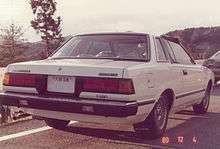
This iteration of the Silvia (sold in United States and Canada as the Datsun 200SX and in Mexico as the Datsun Sakura, Japanese for cherry blossom), available as a 2-door hardtop coupe and a new bodystyle 3-door hatchback. The Japanese market version of the hatchback was called the Gazelle and was exclusive to Nissan Bluebird Store locations sold alongside the Fairlady Z, while the coupe bodystyle Silvia remained exclusive to Nissan Prince Store locations alongside the Skyline. Its sharp-edged styling was shared with the new Nissan Leopard sedan and coupé, also exclusive to Nissan Bluebird Store.
This generation Silvia was uniquely progressive in that it was originally intended to feature a rotary engine, designed and built by Nissan. The resulting unit was fairly unreliable, and forestalled production. Coincidentally, this Silvia shares its chassis code with the Mazda Cosmo, the first Japanese production car to feature a rotary engine. The chassis was shared with the B310 Nissan Sunny and the larger A10 Nissan Violet platform.
The car was redesigned shortly before it was released and the stillborn Wankel power plant was replaced by a line of twin-plug conventional piston engines from the new Z-series range. These included the Z20 and the turbocharged and later the fuel-injected Z18ET, although the latter of the two was only available to the Japanese domestic market and after the mid-life facelift. This took place in late May 1981 and included new bumpers and a reworked front design.[5] Albeit a sporting design, the 135 PS (99 kW) Turbo model received largely the same chassis as regular models and did not have any kind of turbocharger boost indicator.[5] At the time of the facelift, the DOHC FJ20-engined RS model was also introduced.
Gazelle
Nissan rebadged the Silvia as the Gazelle coupé and hatchback so that Nissan's different dealership networks in Japan could all carry their own variants of the model. There are minor cosmetic differences between the two cars such as grille pattern and taillight lenses.[5] Gazelle was treated as a more exclusive model, while the Silvia was the base and sporty models.
 The facelift model Nissan Gazelle XE-II Turbo in Japan
The facelift model Nissan Gazelle XE-II Turbo in Japan 1981-1983 Nissan Gazelle Turbo hatchback (S110) in Japan
1981-1983 Nissan Gazelle Turbo hatchback (S110) in Japan
North America
The Silvia continued to be sold as the 200SX in North America, with either the two-door coupé or the three-door liftback bodywork. It was originally powered by the 2.0 L inline-four L20B engine, although in 1980 California-market cars received the twin-plug Z20 NAPS-Z inline-four of the same displacement.[6] From the 1981 model year, this became the only engine available to the 200SX. Power is 100 hp (75 kW; 101 PS), channeled through a five-speed manual or a three-speed automatic and coupled with the H165 rear axle.[6] For 1982 the 200SX was facelifted and gained the 2.2-liter Z22E engine coupled with the sturdier H190 rear axle. This model produces 103 hp (77 kW) SAE at 5200 rpm.[7] There were no significant changes for 1983.
The top model was the luxurious SL, which received a remote opening hood, trunk, and gas tank lid, more adjustable seats, and a removable glass skyroof.[6] The hatchback model received sportier trim, while the notchback coupé focused more on luxury.[8]
240RS
This generation saw the introduction of the Nissan 240RS (BS110), a coupe fitted with the 2.4-liter DOHC FJ24 engine. The 240RS was built between 1983 and 1985, its production extending the end of the S110 itself. The resulting machine became Nissan's official rally car in the World Rally Championship from 1983 to 1985, with its best result a second place finish in the 1983 New Zealand Rally.
Chief Kogure's Gazelle
As part of their sponsorship of the series, Nissan provided several of their vehicles for the production of the police drama Seibu Keisatsu, including a one-off S110 Gazelle convertible driven by Chief Kogure.
S12
| Nissan Silvia (S12) | |
|---|---|
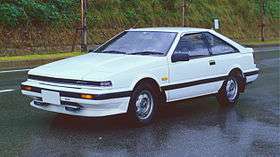 Nissan Silvia Hatchback in Japan | |
| Overview | |
| Also called |
|
| Production | August 1983-1989 |
| Assembly | Kanda, Fukuoka (Nissan Shatai Plant) |
| Body and chassis | |
| Body style | |
| Layout | FR layout |
| Platform | Nissan S platform |
| Powertrain | |
| Engine | |
| Transmission |
|
| Dimensions | |
| Wheelbase | 2,425 mm (95.5 in) |
| Length |
|
| Width |
|
| Height |
|
| Curb weight | 1,170 kg (2,580 lb) |
The S12 was produced from August 1983 to 1989, with revisions to the exterior trim in 1986 (referred to as "Mark II"). It was sold in two configurations — a coupé (often called a "notchback" due to the side profile view of its rear window section) and a hatchback version.
A number of different engines were equipped in the S12 chassis, depending on production year and more specifically on the geographic market. These engines borrowed from previous designs, or in some cases, inspired future engine platforms (with the exception of the FJ series, which was designed solely with Rally competition in mind). For instance, the CA series initially borrowed design cues from the NAP-Z series. The CA18DET's DOHC head design was similar to that utilized in the later "RB" engine series, the inline-six engine that powered the Nissan Skylines. Certain trims had the S12 equipped with an optional V6 engine also shared by the 300ZX (Z31) of the same vintage; this engine would be augmented with dual cam heads for the Z32.
Japan

As with the S110, the S12 chassis in Japan was badged as both a Silvia and a Gazelle. The S12 Silvia in Japan was available in a hatchback as a basic model only, or as a coupé (notchback) in base, RS, and RS-X trims and exclusive to Nissan Prince Store Japanese dealerships as a junior companion to the Nissan Skyline. The S12 Gazelle was strictly a hatchback, available in regular, RS and RS-X variants and exclusive to Nissan Bluebird Store locations as a junior companion to the Fairlady ZX. The RS was equipped with the 2.0-litre DOHC "FJ" engine (FJ20E), while the RS-X was equipped with a turbocharged version of the same engine (FJ20ET). In 1987 Nissan discontinued the FJ Series engine in the S12 and replaced it with the CA18DET (with dual cams and a bigger turbocharger — the CA18DET. Japanese spec Gazelle models came with many options like voice command, fog lights and a variety of different engine options (FJ20E, FJ20ET, CA18DE, CA18E, CA18DET.). The RS-X model also came with different factory alloy wheels. When the S13 Silvia was introduced in 1988 in Japan, the Gazelle nameplate was replaced with the Nissan 180SX as a junior companion to the 300ZX. In Australia there would not be a replacement until the introduction of the Silvia-based Nissan 200SX in 1995.
North America
.jpg)
The S12 Silvia brand in North America was badged as a "200SX". For fear that the North American market would not be as profitable as other markets throughout, Nissan Executives only scheduled the manufacturing of 5,000 of each trim package/engine options in the final two years before the halt of production for the United States, which was in 1988. The S12 "XE" was strictly a notcback coupé, and was only available with a 2.0-litre SOHC, non-turbo engine and made available with either a 5-speed manual or 4-speed automatic gearbox. (CA20E) The hatchback received both the 2.0L SOHC engine, and a 1.8L SOHC Turbo (non-intercooled) engine (CA18ET). For 1987 in the United States, Nissan discontinued the Turbo model and created the "SE" model which had a 3.0L SOHC V6 engine (VG30E), generating 160 hp (120 kW) and 174 lbf⋅ft (236 N⋅m) of torque. This was the same engine offered in the non-turbo 300ZX for that generation. For 1988 the "SE" model received a 5 hp (3.7 kW) gain from using the later "W" series revisions of the VG30E with a total output of 165 hp (123 kW) while torque remained the same at 174 lbf⋅ft (236 N⋅m).
Europe
The S12 chassis in Europe was badged as a "Silvia", with notable exception of Sweden where it was sold as a "180ZX". "ZX" is traditionally associated with the Nissan Z platform, this situation came about to avoid giving the car the same name as the Queen of Sweden. The ZX name was used because Nissan's Swedish importer decided to stop carrying the 300ZX when the naturally aspirated version was discontinued for Europe; the Silvia acted as a partial replacement for the Z-car.[9]
The European S12 was available only in the hatchback configuration, few were equipped with a rally package that included a rally foot brace for the navigator, headlamp guards, headlamp dust cleaners, with the same 1.8L SOHC Turbo (CA18ET) used in North America, and in some areas the 2.0L DOHC "FJ" engine (FJ20E). These models equipped with the rally package were dubbed "Rally Spec". The "FJ" engine series was originally designed for the 240RS rally race car as a 2.4L carburated system (FJ24), and was underbored to 2.0L. The FJ20 also saw use in the "DR30" Nissan Skyline chassis, in both turbocharged and naturally aspirated versions. The CA18ET was also available catalyzed, producing 122 PS (90 kW).
Australia
_SGL_coupe_(2015-08-07)_02.jpg)
_SGL_coupe_(2012-11-25).jpg)
The S12 chassis in Australia, released in October 1983, was badged as a Gazelle. The Australian Gazelle was available in both hatchback and coupé variants.[10] It was equipped with the same 2.0-liter SOHC CA20E engine found elsewhere producing 78 kW (105 hp) at 5,200 rpm, and 160 N⋅m (120 lb⋅ft) of torque at 3,200 rpm.[11] This engine was mated to either a five-speed manual gearbox or a four-speed automatic.[11]
Trim levels comprised the GL hatchback (basic) and the luxury-oriented SGL coupé.
According to the May 1984 brochure, the coupé added: alloy wheels, mudflaps, electric windows/mirrors/antenna, a six speaker sound system (over four), time delay interior lighting, variable intermittent wipers, an armrest, carpet kickpads, and cloth headlining/sunvisors/door trims (over vinyl).[11] An option pack for the coupé added air conditioning, power steering, and power sunroof. The hatchback's option pack added air conditioning, power steering, and power sunroof.[11]
By the time of the August 1985 brochure, the coupé's option pack had been deleted, but the standard SGL coupé added power steering and a manual sunroof (a power sunroof was no longer offered).[12] Air conditioning remained as an option, while power steering was added to the hatchback's option pack.[12] The alloy wheel design was also changed.[11][12]
The facelifted "Mark II" models were released to Australia in circa 1986.
Revisions
The S12 chassis in 1984-86 is referred to as "Mark I", with "Mark II" as a revision in '87. Below lists the description of both.
Mark I
_GL_hatchback_(2008-11-10).jpg)
The first trim of the S12 chassis. Bumpers featured matte-finish raised surfaces, and sides featured half-inch rubstripping. Cars featured a honeycomb radiator grille, and long corner lights. The RS-X trim in Japan and Europe received a hood bulge accent to accommodate the oversized dimensions of the FJ20E/ET engine, and featured a faux front vent with monogram (either FJ20, DOHC, or TURBO); In North America, the 1984 Turbo came with a "TURBO" monogrammed hood bulge accent, although all subsequent North American Mark I hoods were flat regardless of trim. In some markets, the 1984 and 85 could be had with a foam rubber deck spoiler. In 1986 the foam rubber deck spoiler was changed for a fiberglass version with an integrated third brake light. Some hatchbacks and all Turbo models came with ground effects, as did the RS-X coupés These had a combination of plastic mudflaps (monogrammed as either "NISSAN", or "SILVIA" in applicable markets) and accommodating foam rubber sideskirts, as well as a foam rubber lower deflection lip. 1984 year foam rubber sideskirts featured the "NISSAN" monogram.
Mark II
.jpg)
In 1986, the bumpers were updated, and the matte finished surfaces were eliminated for a more uniform surface. Rubstripping was increased to 2-inch height w/ scribe detailing. The honeycomb radiator grille was replaced with a slatted version that spanned the entire front end (previous was shorter), and cornerlights were shortened. The "SE" model and the Turbo (Canada, Europe) came with new fiberglass ground effects and mudflaps, painted in the color of the car, and a new and more pronounced lower deflection lip in the front. All Mark II S12's received a new reverse-cowl hood bulge design to accommodate clearance for the 3.0-litre V6. Optional rear mudflap accents were available.
Drivetrain rear-wheel-drive
Engine
| Engine | Variance | Cylinders | Displacement | Valvetrain | Aspiration | Power | Torque | Drivetrain | Transmission |
|---|---|---|---|---|---|---|---|---|---|
| CA18ET | North America | 4 | 1809 cc | SOHC 8-valve | Single turbo | 120 hp (122 PS; 89 kW) at 5200 rpm | 134 lb⋅ft (182 N⋅m) at 3200 rpm | Rear-wheel drive | 4-speed automatic / 5-speed manual |
| catalyst & dual ignition, Europe |
122 PS (120 hp; 90 kW) | ||||||||
| dual ignition, Europe |
135 PS (133 hp; 99 kW) | ||||||||
| CA18DET | N/A | DOHC 16-valve | 169 hp (171 PS; 126 kW) at 6400 rpm | 156 lb⋅ft (212 N⋅m) at 4000 rpm | |||||
| CA20E | North America | 1974 cc | SOHC 8-valve | Natural | 102 hp (103 PS; 76 kW) at 5200 rpm | 116 lb⋅ft (157 N⋅m) at 3200 rpm | |||
| dual ignition, Australia |
78 kW (105 hp; 106 PS) at 5200 rpm | 118 lb⋅ft (160 N⋅m) at 3200 rpm | |||||||
| FJ20E | Germany | 1990 cc | DOHC 16-valve | 145 PS (143 hp; 107 kW) at 6400 rpm | 129 lb⋅ft (175 N⋅m) at 4800 rpm | ||||
| FJ20ET | N/A | Single turbo | 190 PS (187 hp; 140 kW) at 6500 rpm | 173 lb⋅ft (235 N⋅m) at 4800 rpm | |||||
| VG30E | North America (1987) | 6 | 2960 cc | SOHC 12-valve | Natural | 160 hp (162 PS; 119 kW) at 5200 rpm | 174 lb⋅ft (236 N⋅m) at 4800 rpm | ||
| North America (1988) | 165 hp (167 PS; 123 kW) at 5200 rpm |
Special Editions

In Europe, a limited-run (~250 units?) version of the S12 was produced and sold as the "Silvia Grand Prix" model. Based on a Mark I chassis, it was powered by the FJ20E (with a few known to be sold with the CA18ET), and featured molded-in fiberglass wide body fenders and quarter sections and special edition wheels.
The widebody exterior grabs design cues from popular European rally car platforms of the time (e.g. Audi Quattro, BMW M3 Sport Evolution, Renault 5 Turbo 2, etc.), although Nissan's choice of the FJ20E over the FJ20ET suggests this was more of a "rally inspired" car rather than a serious performance trim. The Silvia Grand Prix holds the distinction as the rarest incarnation of the S12, and is generally considered something of a collector's item. The Mark II revision of the S12 chassis marked the end of the Silvia Grand Prix.
Motorsports
_front-left.jpg)
The elimination of Group B from the World Rally Championship signified the end of Nissan's FJ24-powered 240RS. The FJ20ET-powered Silvia RS-X of 1986 would have been Nissan's first choice, however there was an insufficient number of that exact trim sold in Japan to meet the WRC's Homologation requirements (minimum 5000 units). Nissan had to quickly find a car to replace the 240RS.
The North American 1987 200SX SE V6 was chosen and competed in 1986-89 as a 200SX. Nissan's creation and choice of this car ensured they could sell 5000 cars required for WRC Homologation. The S12 "SE" trim's V6 held the only real appeal to the North American market, allowing Nissan to sell right at 5000 cars to a single specification. The V6 was a very unusual choice as the WRC was dominated by 4-cylinder 2.0 L turbocharged engines, although for similar reasons Toyota entered WRC with the 6-cylinder Supra at the same time. The 200SX achieved a first place in the 1988 Ivory coast rally and second place for two years running in the very challenging Safari Rally 1988 and Safari Rally 1989.
Mark Skaife won the 1987 Australian 2.0 Litre Touring Car Championship driving a Nissan Gazelle entered by the Nissan Motor Company.
S13
| Nissan Silvia (S13) | |
|---|---|
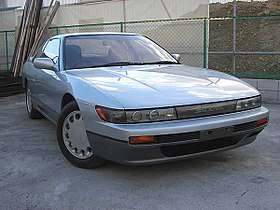 | |
| Overview | |
| Production | 1988–1994 |
| Assembly | Kanda, Fukuoka (Nissan Shatai Plant) |
| Body and chassis | |
| Body style | 2-door coupe 2-door convertible 2-door Fastback |
| Platform | Nissan S platform |
| Related | Nissan 180SX Nissan 200SX (Europe) Nissan 240SX (North America) Sileighty |
| Powertrain | |
| Engine | |
| Transmission | 4-speed automatic 5-speed manual |
| Dimensions | |
| Wheelbase | 2474 mm (97.4 in) |
| Length | 4521 mm (178 in) |
| Width | 1689 mm (66.5 in) |
| Height | 1290 mm (50.8 in) |
| Curb weight | 1,180–1,224 kg (2,601–2,698 lb) |
The S13 Silvia, introduced in mid-1988 the 1989 model year, was immensely popular in Japan. At its introduction in 1988, it won the Car of the Year Japan Award. The Silvia was no longer exported, however; rebadged 180SX were instead sold in most markets. European versions of this car were still known as 200SX. In North America, the S13 (180SX front, all three different bodystyles) was known as the 240SX. In North America, the Nissan 200SX nameplate was on hiatus but would return on a 2-door coupe version of the B14 Nissan Sunny/Sentra (1995–99). Following industry trends, the S13 Silvia switched to relampable fixed headlights. Projector optics were offered as an option.
In Japan, Nissan renamed the Gazelle as the Nissan 180SX, which was exported primarily under the name Nissan 240SX. The 180SX served as the junior companion to the Fairlady ZX at Nissan Bluebird Store Japanese dealerships. As before, the Silvia was exclusive to Japanese dealerships called Nissan Prince Store next to the Skyline.
The S13 Silvia coupe was made from 1988 to 1994, overlapping with the S14 Silvia introduced in 1993. The Nissan Silvia used fixed headlights; whereas, the 180SX, simply a hatchback version of the Silvia, introduced at the same time used pop-up headlights. The hatchback version, called the 180SX, replaced the Gazelle name in Japan and remained in production until 1998.
The S13 was one of the first uses of Nissan's multi-link rear suspension, the technology of which was previewed in concept cars in previous years, such as the Nissan MID4. It also offered a four-wheel steering system for the first time, known as HICAS-II. In 1990, HICAS-II was updated and renamed SuperHICAS. The S13 also saw the introduction of a viscous-type limited slip differential for some models.
S13 Silvias were initially powered by the CA18DE and CA18DET engines carried over from the end of S12 production, with an intercooler added to the CA18DET for a slight increase in stability and power. In mid-1990, (for the 1991 model year) the SR20DE and SR20DET engines debuted, offering improvements across the board in power and torque due to increased displacement and a more efficient turbocharger than was offered on the previous cars. One of the other simple changes that were made between the CA generation and the SR generation was the switch to a single colour paint job, instead of the two-tone colour sets that were previously offered. On top of this, the SR motor later debuted another variant of the platform known simply as the "blacktop". Identifiable by its black and silver rocker-cover (as opposed to the traditional red/silver cover), it featured a number of minor changes, resulting in a little performance gain. It is vastly different from the more powerful "notch top" used in the S14 and S15 variants.
In the U.S. the S13 was replaced after the 1994 model year by the new S14 design but lived on until 1998 in Japan with a major facelift, the 180SX Aero (Type X). This was the "Kouki" generation, while the previous (or 'middle') generation was referred to as "Chuki". The Kouki featured newly design tail lights a redesigned aero body kit and outfitted with an airbag. In 1998, the S13 Silvia was resurrected, in part. A variant was produced by Kid's Heart for Nissan called the Sileighty, which featured the 180SX body with the front end from the Silvia. The Sileighty style was originally created by Japanese enthusiasts for their own 180SX's, and is still a common modification for the 180SX and 240SX fastback. The Sileighty also made an appearance in a Japanese anime and manga series known as Initial D. The series (based around the Japanese motorsports of Touge and drifting) featured the Sileighty in one of the last battles of the First Stage (or first season in the anime).
The creation of the Sileighty then followed by another version of the Silvia known as the Onevia. Based on the chassis of the S13, the front end of the Silvia would be removed and replaced with the front end of a 180SX. The Onevia was never retailed as a complete car in Japan (though it was in North America: the coupe version of the 240SX was essentially a left-hand drive version of the Silvia with the 180SX/240SX nose).
There was also a retro-styled car (á la the Zimmer Golden Spirit) which used the S13 Silvia's centre portion, engine, and underpinnings. It is called the Mitsuoka Le-Seyde and was built in a very limited series in 1990.
The car has also been popular with multiple diecast manufacturers like HotWheels, which have released several iterations of it over the years.
Convertible
A Silvia convertible was briefly offered soon after the start of production and sold in limited numbers. Demand, at the time, was low perhaps due to high cost (3.25 million Yen in 1988), heavier curb weight, and chassis flex. The Silvia convertibles were a conversion done by Autech Japan, Inc.[13] and the production was entrusted to Takada Kogyo with a manufacture date of July 1988. A total of 603 Autech convertibles were produced in the following color codes: TH1 - velvet blue (430), 5G7 - green two-tone lime (50), 5H6 - warm two-tone white (70), AH3 - cranberry red (40), and DH0 dark green (10). The other 3 were made to order for Nissan and the color is unknown. They came equipped with K series trim including the turbocharged CA18det engine. All of the 600 publicly available cars were sold with 4-speed automatic transmission.
It was unrelated to the 240SX convertible offered in North America, which was a local conversion by ASC.
Trim level designation
The S13 Silvia was the first S-series car to use the J's, Q's, and K's designations for the different trim packages. These names are references to the face cards of English playing cards.
The J's was the base model. The Q's model offered a slightly more refined experience and received electric options and an available LSD. The K's grade received the turbocharged CA18DET or SR20DET (depending on the year of manufacture) in addition to the options offered on the Q's.
On top of the K's and Q's models, the Club and Diamond Selection packages came with specific options bundled together. For example, all K's Club Selections came with projector headlamps, a rear spoiler, and 15" aluminum wheels while all Q's models came out with automatic climate control.
The Silvia A's "Almighty" was introduced in late 1992. Trim wise, the Almighty slotted between the J's and Q's, offering options not available on J's, but not including all the standard features of the Q's. The only available engine/transmission was the naturally aspirated SR20DE coupled with the four-speed automatic or a five-speed manual.
S14
| Nissan Silvia (S14) | |
|---|---|
.jpg) | |
| Overview | |
| Also called |
|
| Production |
|
| Assembly | Kanda, Fukuoka (Nissan Shatai Plant) |
| Body and chassis | |
| Body style | 2-door coupe |
| Platform | Nissan S platform |
| Powertrain | |
| Engine | |
| Transmission | |
| Dimensions | |
| Wheelbase | 2525 mm (99.4 in) |
| Length | 4498 mm (177.0 in) |
| Width | 1727 mm (68.0 in) |
| Height | 1288 mm (50.7 in) |
| Curb weight | 1253 kg (2762 lb) |
The S14 Silvia debuted in Japan towards the end of 1993. It was lower and wider than the S13. New rounded styling contributed to the illusion of a greater increase in size than actually occurred. Wheelbase and track were both increased, leading to slightly improved handling. Unlike export markets, where sales of the S14 chassis variants faltered, the Silvia remained popular in Japan. However, the width dimension exceeded 1700 mm, which pushed this generation out of the compact class tax bracket, which also made Japanese buyers liable for higher road taxes. also this model was unpopular.because specialty market coincided with the time that was pushed to RV or SUV,the sales volume is not gained popularity of young people.The fastback and convertible bodystyles was discontinued internationally, leaving only the coupe in production.
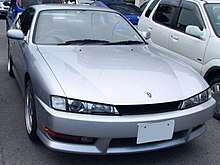
Trim level designations were similar to the S13, however the Club Selection package was dropped. "Aero" variants of the Q's and K's were offered that featured large rear wings and mild ground effects.
The S14 Silvia K's received a new version of the SR20DET, with a slight bump in power due to the implementation of Nissan's variable cam timing system known as N-VCT, on the intake cam, and a larger T28 turbocharger.
There was a mild styling update to the S14 during 1996, which added aggressive-looking projector headlamps and tinted taillights to all models. Fascias and other exterior trim pieces were also revised. The turbocharger now used a more efficient ball bearing center section. This updated version is also known as the kouki (後期, literally "later period") S14, or by enthusiasts as the S14A. It was sold as the second generation 240SX in North America from 1995 to 1998, equipped with the non-turbo KA24DE engine. The final model year of S14 production in all markets was 1999, called the Touring Model, which had a better engine block, pistons, and better acceleration in lower gears.
270R
The 270R was a limited edition vehicle developed by Nissan Motorsports. The vehicle was built on the S14 chassis but had many enhancements over the Silvia. Only 50 270Rs were ever built and they were only produced in 1994. The '270' is in reference to the horsepower of the unique car as opposed to the displacement of the engine (as other vehicles, including the 240sx, were previously named upon). The 270R featured a vented hood with a front-mounted intercooler, Nismo 'Edge' Aero kit, heavy duty clutch, 2-way limited slip differential, NISMO logo front and rear seats among other upgrades. All the 270s were painted black with 'Nismo 270R' badging above the rear wheels and a product numbered plaque in the glove compartment.
Autech Version K's MF-T
Tuning company Autech, has a tuned adaption of the CS14 King's variant. This includes Aero style HUD with white displays and gauges for oil pressure, boost, and voltage in the centre console, along with a MOMO steering wheel and leather gear knob. The interior trim is also revised.
Handling improvements include multi-link suspension, firmer shocks and springs, front strut brace, and a rear sway bar. A large F40 style rear spoiler and aero bodykit with Autech indicators are also fitted. An "Autech Version K's MF-T" badge and sticker can be found on the boot.
An IHI ball bearing turbo (VN14) was fitted in favour of the Garrett T28 for slightly quicker response and flow. Larger 480 cc injectors found in the later S15 Spec R's were also fitted as well as a thicker 80 mm intercooler also found in S15's. To help expel exhaust, a higher flowing Fujitsubo Giken (FGK) exhaust was fitted.
The engine is an Autech-tuned SR20DET that produces 182kW (245hp/250PS).
According to the Autech website, the vehicle is still available at a cost of ¥2.99 million yen (around 27,000 US dollars).
S15
| Nissan Silvia (S15) | |
|---|---|
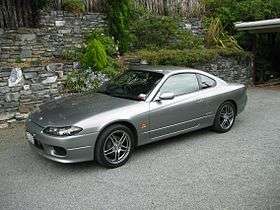 Nissan Silvia 200SX (S15) in New Zealand | |
| Overview | |
| Also called |
|
| Production | January 1999–2002 |
| Assembly | Kanda, Fukuoka (Nissan Shatai Plant) |
| Body and chassis | |
| Body style |
|
| Layout | FR layout |
| Platform | Nissan S platform |
| Powertrain | |
| Engine | |
| Transmission |
|
| Dimensions | |
| Wheelbase | 2,525 mm (99 in) |
| Length | 4,445 mm (175 in) |
| Width | 1,695 mm (67 in) |
| Height | 1,285 mm (51 in) |
| Curb weight | 1,200–1,450 kg (2,646–3,197 lb) |
Japan saw a new version of the Silvia: The S-15 in 1999, now boasting 250 PS (247 bhp; 184 kW) at 6,400 rpm and 275 N⋅m; 203 lbf⋅ft (28 kg⋅m) at 4,800 rpm of torque from its SR20DET Inline-four engine,[14] thanks to a ball bearing turbocharger upgrade, as well as improved engine management system. The non-turbo SR20DE produced 165 PS (163 bhp; 121 kW).[15]
The S15 Silvia included aggressive styling inside and out, updating the previous Silvia styling in-line with modern car design trends. The body dimensions were reduced from the previous generation so that it would comply with Japanese Government compact class, which had an effect on sales of the previous model.
The S15 Silvia model lineup was initially simplified to just the Spec-S and Spec-R, both models offering an "Aero" variant with a large rear wing and side skirts/valances.
This generation of the Silvia was only sold in Japan, Australia and New Zealand but was available as a grey import in most other countries. In Australia and New Zealand the car was sold as the Nissan 200SX.
Within the Australian domestic market (AUDM), the S15 sold in 2 trim levels as noted above; Spec-S and Spec-R - however both models featured the SR20DET motor, albeit slightly detuned from the JDM spec cars. Nissan S15s were never officially sold with the naturally aspirated SR20DE engine in Australia or New Zealand. These two models were available at Nissan showrooms until the Nissan 200SX GT was introduced in 2002, the last year of production for the S15. Main differences here were namely the wheels being finished in a silver shadow chrome, chrome interior door handles, chrome gear selector surround, "sports" metal pedal set and an updated larger rear wing.
As of August 2002, Nissan stopped producing the S platform with the S15-series Nissan Silvia being the final variant. Production of the Silvia ended amidst Nissan's efforts to reduce its myriad of platforms. The S15 Silvia was therefore the last car to hold the Silvia badge. Nissan's worldwide sports car platform is now the FM platform, which underpins the current Fairlady Z (the 350/370Z outside Japan), as well as the 2001–present Nissan Skyline (the Infiniti G35/37 in North America).
Variants
Spec-R
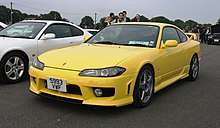
The Spec-R differed from previous Silvia models by featuring a 6-speed manual gearbox as well as a 4-speed automatic transmission. The Spec-R also included extensive chassis and suspension strengthening via the use of larger anti-roll bars and strut bracing. The S15 featured the same 4-piston front brake calipers that were found in the Z32 300ZX but included a larger brake booster.
One of the biggest changes to the S15 model of the Silvia fitted with the 6-speed manual transmission built by Aisin Seiki was the implementation of a helical limited-slip differential. The result was a safer, more track suited drive; in some contrast to its drifting heritage and subsequent media attention. All other versions of the Silvia (S14, S15 Spec S JDM) came with the viscous limited slip differential.
HICAS (High Capacity Active Steering) four-wheel steering was available as an option.
Spec-S
The Spec-S featured a 5-speed manual transmission (in addition to a 4-speed automatic available on both the Spec-S and the Spec-R). It lacked the additional chassis support of the Spec-R; featured 4-piston front brake caliper and a slightly smaller brake booster. The Spec-S came only with an open differential. Australian-delivered Spec-S models featured the same helical differential, chassis bracing and 6 speed manual transmission as the Australian market Spec-R models.[16]
The S15 line was later expanded to include various luxury and upgrade option packages for both the Spec-S and Spec-R. Autech, a specialty car developer, also offered several tuned versions of the S15; one with body and interior trim modeled after the Ferrari 456, called the style-A, available in both Spec-S and Spec-R based trims; and a second tuned version was based on the Spec-S trim level with the engine output increased to 200 hp (150 kW) through the use of increased compression, more aggressive camshafts, and free-breathing intake and exhaust tracts, along with ECU tuning and upgrades to the chassis and suspension. This version also included the 6-speed transmission and other upgrades normally found only in the Spec-R.
Silvia Varietta
In Japan, Nissan offered a retractable hardtop variant of the Silvia, called the Varietta. The Varietta was built by Autech and was based on the Spec-S model, featuring the same naturally aspirated engine, with a choice of the 5-speed manual transmission or the 4-speed automatic transmission. This is a rare type of Nissan Silvia which is uncommon in most places as only 1143 cars were produced.
Motorsports
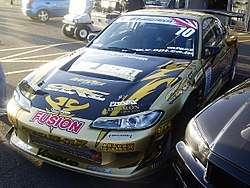
The S-chassis is a popular drift car, especially the S13 through S15 vehicles. This is due to the extreme versatility and huge aftermarket for the S-chassis, many professional racecars have been built just by off the shelf suspension and engine components. The car has enjoyed success in the sport, having won 7 D1 Grand Prix championships with 5 different drivers driving the S15 (Nobuteru Taniguchi:2001; Ryuji Miki:2004; Yasuyuki Kazama:2005; Masato Kawabata:2007; Youichi Imamura:2009, 2010, 2011. Odi Bakchis, a pro-level drifter from USA that started drifting in 2011, has an S14 that races in Formula Drift, finishing third in the Formula Drift USA Championship. He has multiple event wins and has placed in the Top 5 overall in Formula Drift for the past 4 years. In 2018 Formula Drift driver James Deane campaigned and won the PRO championship in the Worthouse Drift Team S15.[17]
In Europe, the S13 has also been very popular with pro-level drifters, especially in countries like the United Kingdom, Poland, France, Germany, Sweden, Norway, Russia and Ukraine. While some have opted to use the SR20DET engine from Nissan, most drivers have swapped in a larger RB25DET unit, or even the Toyota Supra derived 2JZ, like Pawel Trela from Poland.
Silvias have been raced successfully in the All-Japan Grand Touring Car Championship (now Super GT) and its predecessors. Both the S14 and S15 generations of the Silvia won the GT300 class championship in 1997 and 2001 respectively. In the late Eighties, when Group B was banned, S110 and S12 Silvias also saw limited success in rallying, mainly on endurance rallies. During the S13's production, there was a one-make series in Japan. The S13s were also successful in racing in the IMSA GTU class during the 1990s.
The Silvia S15 of Under Suzuki has dominated the Tsukuba circuit lap time record for some time. After it defeated the HKS CT230R LanEvo for the record in 2012, Under Suzuki's S15 has been resetting Tsukuba's lap time record. The latest lap record is currently timed at 50.366s, even faster than an official JGTC race car ARTA NSX.[18][19][20][21]
References
- Australian Motor Manual's 1967 Road Test Annual, page 40
- 1965 Nissan Silvia CSP311, www.earlydatsun.com Archived 2017-05-24 at the Wayback Machine Retrieved on 15 February 2015
- "Nissan Silvia". Automotive Engineering International. Society of Automotive Engineers. 107: 23. 1999.
- 1981 Datsun Silvia brochure cover (France), www.flickr.com Retrieved on 19 march 2015
- Hall, Bob (1981-08-24). "Japan's version of the 200SX gets a definite boost". Autoweek. Vol. 31 no. 34. Crain Press Inc. p. 14. ISSN 0192-9674.
- Hogg, Tony (ed.). "1981 Buyer's Guide". Road & Track's Road Test Annual & Buyer's Guide 1981 (January–February 1981): 90.
- Büschi, Hans-Ulrich, ed. (March 10, 1983). "Automobil Revue '83". 78. Berne, Switzerland: Hallwag, AG: 404–405. ISBN 3-444-06065-3. Cite journal requires
|journal=(help) - Datsun: Suggested retail prices for 1981 Datsun Models★ (Sales Training/Dealer Support), Gardena, CA: Nissan Motor Corporation in U.S.A., 1980-09-25, pp. 4–5
- Svallner, Björn (1987-11-11). "Nya motorer från Nissan" [New engines from Nissan]. Teknikens Värld (in Swedish). Stockholm, Sweden: Specialtidningsförlaget AB. 39 (24): 20.
- "Nissan Gazelle". Unique Cars and Parts. Retrieved 14 April 2016.
- "Nissan Gazelle (S12) brochure" (PDF). Nissan Australia. May 1984. Archived from the original (PDF) on 5 November 2010.
- "Nissan Gazelle (S12) brochure" (PDF). Nissan Australia. August 1985. Archived from the original (PDF) on 15 April 2016.
- http://www.autech.com/history/sv/silvia_convertible_1988.html
- "1999 Nissan Silvia spec-R S15 GF-S15". carfolio.com. February 28, 2013. Retrieved July 25, 2018.
- "1999 Nissan Silvia spec-S S15 GF-S15". carfolio.com. February 28, 2013. Retrieved July 25, 2018.
- "Nissan Factory Service Manual - Free Nissan FSM". Guapro Media. Retrieved 2012-07-30.
- Terrell, Joe. "Ultimate Nissan Silvia S15 Guide". Drifted. Retrieved August 20, 2019.
- "Tsukuba Circuit lap time record: 51.127!". Farmofminds.com. 2014-12-26. Retrieved 2017-03-16.
- "Under Suzuki resets Tsukuba lap record – again! – World Time Attack Challenge". Worldtimeattack.com. Retrieved 2017-03-16.
- "Uncharted Territory: Under Suzuki's 52-sec Lap". Speedhunters.com. Retrieved 2017-03-16.
- http://www.speedhunters.com/2017/12/time-attacked-is-it-all-over/
External links
| Wikimedia Commons has media related to Nissan Silvia. |
- S15oc.com - Official S15 Owners Club - Forums, Guides, Technical Support, Events, Classified Adverts and more
- S12Silvia.com - Blog, Forum, and Tech for the International S12 Community
- 200SX.gr Hellas 200sx Club
- SXOC UK 200sx owners club
- Nissan Silvia S15—Archive of Nissan's official site for the S15 Silvia. (in Japanese)
- Club-S12.org - International Nissan Silvia/Gazelle/200SX S12 Site - International Nissan S12 Chassis specific site.
- Nissan Silvia—Australian Nissan Silvia Club.
- SilviaWA - Nissan Silvia Car Club of Western Australia
- Zilvia - S chassis and Z chassis owners
- Ultimate Nissan Silvia S15 Guide - S15 model information, specifications, motorsport history and common performance upgrades
- History of the Silvia Autospeed Magazine (note: some technical inaccuracies and minor nomenclature errors)
- Paper scale model of the Nissan Silvia. To download, print and build yourself.
- Nissan Silvia Review and test drive Nissan Silvia S15